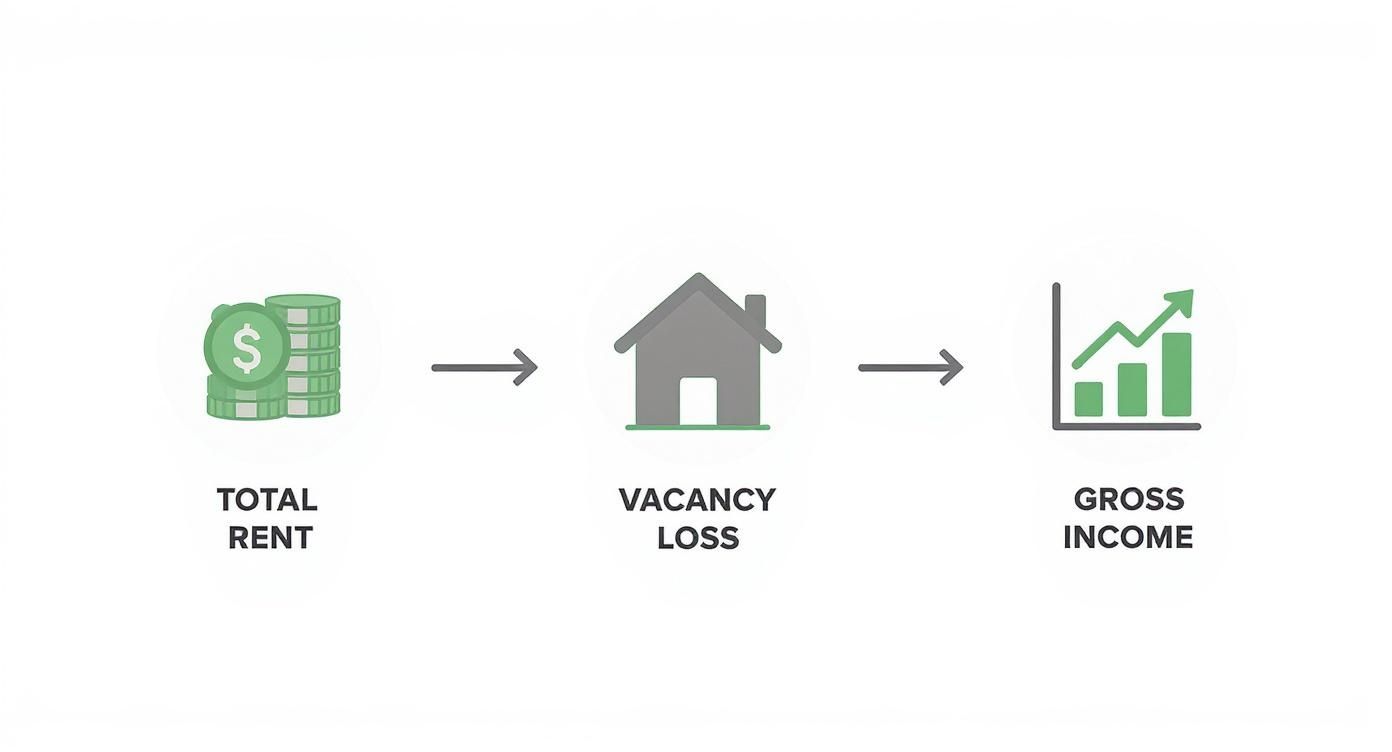Your 2025 Guide to the Rental Property Cash Flow Calculator
A solid rental property cash flow calculator is the most important tool in your real estate investment toolkit. It pulls you out of the risky world of "gut feelings" and plants you firmly in the land of hard data. It makes you look past the pretty pictures and analyze a property's financial potential, making sure your investment is built on numbers, not just a good vibe.
Why Gut Feelings Fail in Okanagan Real Estate Investing

Let's be honest, investing in the Okanagan rental market is exciting. It's incredibly easy to get swept away by a property's potential, especially in a place this beautiful. We’ve seen it happen time and again—an investor falls head over heels for a stunning lake view in West Kelowna or a charming, historic home in Penticton and makes a purely emotional decision.
Unfortunately, emotion is a terrible business partner when you’re investing.
That amazing view doesn't pay the mortgage, and the historic charm won't cover the property taxes. This is exactly why relying on a 'gut feeling' is one of the biggest—and most common—mistakes you can make in the Kelowna real estate market.
Moving From Emotion to Evidence
Think of a rental property cash flow calculator as your best defense against emotional investing. It’s a completely unbiased tool that strips away the excitement and lays out the cold, hard facts of a property's financial health. It’s the business plan for your investment.
Using a calculator forces you to account for every single expense, not just the obvious ones. Beyond the monthly mortgage payment, you have to get real about:
Property Taxes: These can vary a lot between Kelowna, Vernon, and the surrounding areas.
Homeowners Insurance: This is absolutely essential for protecting your asset.
Strata Fees: A major monthly cost for condos and townhomes that can eat into your profit.
Potential Vacancies: No property stays rented 100% of the time. Budgeting for those empty months is critical.
Maintenance and Repairs: From a leaky faucet to a new hot water tank, unexpected costs are a guarantee, not a possibility.
At Vantage West Realty, our founder AJ Hazzi has always emphasized a data-first approach. An investment has to make sense on paper long before you ever sign the closing documents. We're here to guide you through those numbers.
Building a Predictable Portfolio
When you get into the habit of running the numbers through a cash flow calculator for every single potential purchase, you build a system for making smart, repeatable decisions. You’ll start to see patterns. You'll get faster at spotting which Kelowna homes for sale align with your financial goals and which ones are likely to become a massive headache.
This shift from a gut-based approach to a data-driven one is the single most important step you can take to build a successful, cash-flowing real estate portfolio here in the Okanagan. It’s how you make sure each property you add actually contributes to your bottom line, creating a stable and predictable source of income for your future.
Gathering Your Key Numbers for an Accurate Calculation

A rental property cash flow calculator is an incredible tool, but it lives by one simple rule you can't ignore: garbage in, garbage out. The final number it gives you is only as good as the data you feed it. So, before you can confidently analyze a potential investment in Kelowna or Vernon, you need to do a bit of homework.
This means looking beyond the obvious figures like the purchase price and your down payment. You have to dig into the nitty-gritty details that truly determine whether a property makes money or loses it. Getting these numbers right from the start is the foundation of any reliable analysis.
Your Essential Expense Checklist
Let's break down the key figures you'll need to pull together. Think of this as your pre-flight checklist before you run any calculations.
Property Taxes: Don't guess on this one. You can find the previous year's taxes right on the property listing or by checking the municipality’s website. It's a significant annual expense that you have to account for accurately.
Homeowners Insurance: Get a real quote. Call an insurance broker, give them the property details, and ask for an estimate on a landlord's policy. The cost can vary quite a bit based on the home's age, location, and type.
Strata or HOA Fees: If you're looking at a condo or townhouse, the monthly strata fee is non-negotiable. This fee covers the maintenance of common areas and can have a massive impact on your monthly cash flow.
A common mistake we see is underestimating the small, recurring costs. A few hundred dollars in strata fees can easily be the difference between a property that cash-flows and one that costs you money each month. We'll help you spot these details.
Budgeting for the Unexpected
Now for the expenses that aren't fixed. These are the variables that often trip up new investors, so it’s important to be realistic—and maybe even a little conservative.
Maintenance and Repairs
You may have heard of the "1% rule," which suggests setting aside 1% of the property's purchase price each year for maintenance. For a $700,000 home in Kelowna, that’s $7,000 per year. While it’s a decent starting point, Okanagan properties often have unique factors. An older home in Penticton with a huge yard will likely need a bigger budget than a brand-new condo downtown.
Property Management Fees
Are you planning to manage the property yourself? If not, you absolutely need to budget for professional management. These fees typically range from 8-12% of the monthly rent. That cost buys you peace of mind and frees up your time, making it a critical number to plug into your rental property cash flow calculator.
Your financing is the other huge piece of the puzzle. The interest rate on your mortgage directly impacts your monthly payments and, ultimately, your profitability. To get a handle on all your options, take a look at our complete guide on how to refinance your mortgage. Nailing down the best possible rate can dramatically improve your cash flow for years to come.
How to Accurately Project Your Rental Income
Alright, let's switch gears and talk about the income side of the equation. This part seems straightforward—it's just the monthly rent you collect, right?
If only it were that simple. To get a truly accurate picture of your potential earnings, you have to plan for the realities of being a landlord, especially here in the Okanagan.
The most important reality to account for is the vacancy rate. It's a hard truth, but no property stays occupied 100% of the time, forever. Tenants move out, and it can take time to find new ones, clean the unit, and get it ready. Building a buffer for this downtime is non-negotiable.
Factoring in Vacancy
In a competitive market like Kelowna's, it’s tempting to assume you'll have a lineup of tenants waiting. And while demand is strong, a conservative estimate for vacancy is your best friend. In our market, a vacancy rate of 3-5% is a healthy and realistic assumption.
This means that for a property renting at $2,500 per month ($30,000 annually), you should budget for losing between $900 and $1,500 per year to vacancy. That small adjustment can be the difference between a profitable investment and one that causes financial stress. Understanding the typical market rents in Kelowna is your first step to getting this number right.
Our team at Vantage West constantly analyzes the Okanagan real estate market. We can give you a clear picture of typical vacancy rates for a specific neighbourhood—whether it's a condo in downtown Kelowna or a family home in Penticton—so your projections are based on real-world data, not guesswork.
Looking Beyond Monthly Rent
While rent is your primary income, don't forget other potential revenue streams. These might seem small, but they add up and contribute to your Gross Operating Income (GOI), a critical number for your cash flow calculator.
Consider adding these to your income projections:
Pet Fees: Many tenants in the Okanagan have pets and are more than willing to pay a monthly fee.
Parking Fees: If your property has extra or desirable parking spots (especially in dense areas), you can often charge for them separately.
Laundry Income: For multi-unit properties, coin-operated laundry can be a consistent source of extra cash.
These additional income streams, combined with your projected rent (minus vacancy), give you your true GOI. This is the top-line number you'll use to start subtracting expenses, getting you one step closer to your final cash flow figure.
Calculating Your True Net Cash Flow
This is where all your careful research comes together. You’ve tallied up the potential expenses and projected your income—now it’s time to see what the numbers really say about your potential Kelowna investment property. This is the moment of truth.
You'll start with your Gross Operating Income (GOI), which is your total annual rent minus your vacancy loss buffer. From there, you subtract all the operating expenses you gathered earlier.
The number you're left with is your Net Operating Income (NOI).
Think of the NOI as the property's pure profit before your mortgage is factored in. It’s a crucial metric that tells you how profitable the asset is on its own, independent of your financing strategy.
The visual below shows the simple flow from collecting rent to figuring out your gross income.

This process really drives home why accounting for vacancy loss is a non-negotiable step before you can even begin to subtract other expenses.
From NOI to Your Pocket
The final step is the most important one for your bank account. You take your monthly NOI and subtract your monthly mortgage payment—that's the principal and interest combined.
What's left is your true monthly cash flow. This is the real money that actually lands in your bank account each month after everyone else has been paid.
A Kelowna Condo Case Study
Let's make this real with a hypothetical example of a two-bedroom condo in Kelowna. We'll plug in some realistic numbers to see how it all shakes out.
To show how the numbers flow from income to expenses to your final take-home amount, here’s a simplified breakdown.
Sample Cash Flow Calculation for a Kelowna Condo
Item Monthly Amount Annual Amount
Gross Potential Rent | $2,600 | $31,200 |
Vacancy Loss (4%) | -$104 | -$1,248 |
Gross Operating Income | $2,496 | $29,952 |
Property Taxes | -$200 | -$2,400 |
Insurance | -$75 | -$900 |
Strata Fees | -$350 | -$4,200 |
Maintenance (5% of rent) | -$130 | -$1,560 |
Property Management (8%) | -$208 | -$2,496 |
Net Operating Income | $1,533 | $18,396 |
Mortgage Payment (P+I) | -$1,350 | -$16,200 |
Net Cash Flow | $183 | $2,196 |
As you can see, this property generates a positive cash flow.
In this scenario, after subtracting all operating expenses from your gross income, you end up with a Net Operating Income (NOI) of $1,533 per month. This is the property's profit before the mortgage.
Now, let's assume your monthly mortgage payment is $1,350.
Subtract that from your NOI: $1,533 - $1,350 = $183.
Your true monthly cash flow is $183. This is the positive return you earn every single month. It's also important to remember that many of these expenses can work in your favour at tax time. For a deeper dive, you can explore our guide on key rental property tax deductions that every Okanagan investor should know about.
This simple calculation, when done right, gives you the clarity to move forward with confidence. It’s how you separate the winners from the properties that only look good on the surface.
So, you've plugged all the numbers into your rental property cash flow calculator and now you're staring at a final figure. What does it actually mean?
Is a positive cash flow of $250 a month a solid win? Is $600 a month a home run?
The honest answer? A "good" cash flow is entirely personal. It all comes down to your unique investment goals—your strategy is what defines a successful number for you.
Looking Beyond the Monthly Number
Don't get me wrong, seeing any positive cash flow is fantastic. It means the property is paying for itself and putting a little extra in your pocket. But to really understand how that investment is performing, you need to dig a bit deeper.
This is where a couple of key metrics come into play. They help you compare an investment property in Kelowna against one in Vernon, or even against a completely different type of investment.
The two I always have my clients focus on are the Capitalization Rate (Cap Rate) and the Cash-on-Cash Return.
Cap Rate: Think of this as the property's rate of return based on its income and current market value. It’s a great way to measure profitability without factoring in your personal financing situation.
Cash-on-Cash Return: This one is all about your money. It measures the annual cash flow you get back against the actual cash you put in (your down payment, closing costs, etc.). It shows you exactly how hard your initial investment is working for you.
A lower cash-on-cash return might be perfectly acceptable for a property in a high-growth area of West Kelowna where you expect significant long-term appreciation. On the flip side, an investor focused purely on immediate income might prioritize a much higher cash-on-cash return in a more stable, established neighbourhood. We help our clients clarify these goals.
Okanagan Context Is Everything
The right numbers really depend on what game you're playing. Are you in it for the long haul, banking on property appreciation over the next 10-20 years? Or do you need strong monthly income right now to support your lifestyle?
Some real estate markets have high property values and lower immediate cash flow but boast incredible long-term growth potential. While some investors focus on that long-term value, here in the Okanagan, our job is to help you find the balance that feels right for you. By analyzing the results from your rental property cash flow calculator, we can pinpoint properties that truly align with your financial goals. That way, your next move is a confident—and profitable—one.
Your Top Rental Cash Flow Questions Answered
When you first dive into a rental property cash flow calculator, it’s easy to get bogged down in the numbers. But what do those figures actually mean for your investment strategy here in the Okanagan? It’s a question we get all the time from people thinking about buying a home in Kelowna to rent out.
Let's walk through some of the most common questions aspiring investors ask us.
How Much Should I Budget for Repairs on a Kelowna Property?
The classic "1% Rule" is a decent starting point. The rule suggests you set aside 1% of the home's value every year for maintenance. So, for a $700,000 home, you’d be looking at $7,000 annually.
However, anyone familiar with the Okanagan knows a property's age and type can throw a wrench in that simple math. A newer downtown condo will almost certainly demand less work than an older single-family home in Penticton with a sprawling yard and mature trees.
That's why I always tell my clients to be conservative and budget between 1-2%, especially for older homes or properties with features like swimming pools or extensive landscaping that are common around here.
What Is a Good Cash-on-Cash Return for an Okanagan Rental?
Honestly, there's no single magic number. A "good" return is deeply personal and depends entirely on your goals.
Many seasoned investors I work with aim for a cash-on-cash return of 8-12%. But let's be real—that can be a tough target in a competitive, high-value market like Kelowna.
On the flip side, some investors are perfectly happy with a lower initial return, say 4-6%, if the property is in a high-appreciation area like the Lower Mission. They’re playing the long game, banking on future growth to build their wealth. The key is to define your financial goals first, then hunt for a property that fits your plan.
Don’t get caught up chasing a specific number you saw online. Your financial goals are unique, and your investment strategy should be too. We’ll help you focus on what works for your big picture.
Should Appreciation Be Part of My Cash Flow Calculation?
In a word: no. This is a big one, and it's where a lot of new investors get tripped up.
Cash flow is the money moving in and out from day-to-day operations. It’s what’s happening right here, right now.
Appreciation, on the other hand, is the increase in your property's value over time. You only see that money when you sell or refinance. While the potential for appreciation is a massive part of why people invest in Okanagan real estate, it’s speculative.
A solid, sustainable investment should generate positive cash flow on its own merits, without relying on a potential future payday. Think of cash flow as your safety net and appreciation as the long-term bonus.
Can Vantage West Help Me Find the Numbers for My Calculation?
Absolutely. This is a huge part of what we do for our investor clients. We live and breathe this stuff.
With our deep roots and experience in the Kelowna and greater Okanagan market, we can provide you with realistic rental rate estimates, up-to-date comparable sales data, and genuine insights into typical costs like property taxes for specific neighbourhoods. Our goal is to give you the accurate, reliable data you need to make an informed decision.
If you’re thinking about buying or selling an investment property in Kelowna, Vantage West Realty can help you make your next move with confidence. Reach out today.



